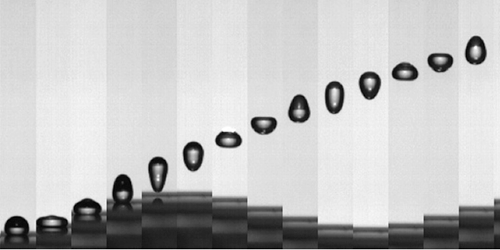September 11, 2017 report
Drops of water found to spring from oscillating surface faster than the surface moves

(Â鶹ÒùÔº)—A team of researchers with the University of Côte d'Azur in France has found that drops ejected by an oscillating surface can at times travel faster than the surface that ejected them. In their paper published in the journal Â鶹ÒùÔºical Review Letters, the team describes experiments they conducted by flinging water from a superhydrophobic surface and what they found.
If you place water on a bendable piece of vibrating plastic, the water droplets will be flung off into the air as the surface undulates. In this new effort, the researchers found that in some specific cases, some of those water droplets can actually travel faster into the air then the plastic base that pushed them. The researchers made this observation as they placed water drops onto a thin piece of plastic made of fluorinated polymers, which they note is similar to Teflon. The team then attached a device that vibrated the plastic at frequencies between 20 and 70Hz. As the oscillator was turned on, the researchers timed the speeds of the drops as they were flung into the air.
The group reports that the highest speed attained by the drops occurred at the halfway point to its peak, after which it slowed then fell back to the surface. But they also found that some of the droplets left the surface at roughly 1.6 times the speed of the rising surface.
To better understand what was occurring and why, the researchers took a closer look at the drop as it was being pushed off the surface. They found that it was squished slightly, like a tennis ball being hit by a racket. And like a tennis ball, the drop rebounded as it was being pushed off the surface. That rebound added to the release speed. The team describes the effect as superpropulsion. They found that the increase in speed of the drop was dependent on the size of the drop vibration compared to the oscillation frequency—the biggest gains came when the drop vibration frequency was approximately three times that of the surface's frequency. The researchers also compared the effect to the added lift a person gets on a trampoline when pushing at just the right moment.
More information: Christophe Raufaste et al. Superpropulsion of Droplets and Soft Elastic Solids, Â鶹ÒùÔºical Review Letters (2017).
ABSTRACT
We investigate the behavior of droplets and soft elastic objects propelled with a catapult. Experiments show that the ejection velocity depends on both the projectile deformation and the catapult acceleration dynamics. With a subtle matching given by a peculiar value of the projectile/catapult frequency ratio, a 250% kinetic energy gain is obtained as compared to the propulsion of a rigid projectile with the same engine. This superpropulsion has strong potentialities: actuation of droplets, sorting of objects according to their elastic properties, and energy saving for propulsion engines.
Journal information: Â鶹ÒùÔºical Review Letters
© 2017 Â鶹ÒùÔº





















